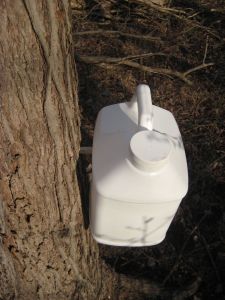Maple Sap is Flowing – Time to Make Syrup!
The nights are cold with temps below the freezing point. Daytime is noticeably warmer – you want to linger in the sunshine. It begins to feel like spring is on the way.
That’s what’s needed for sap to start flowing in the maple trees. Stored in their roots and trunk, with the right temperature conditions, the sap begins to flow upwards to help make leaves.
A small hole can be tapped into the tree; a “spile” inserted for the fluid to flow through; and a bucket hung to collect the dripping sap.
A tapped tree at Marshy Point Park:
The sap only contains 2-4% sugar (or less, depending upon the type of maple tree). It’s boiled (for a long time) until it concentrated enough to become syrup, candy, or sugar. Yumm!
But, it takes 50 gallons of sap to make 1 gallon of syrup. That’s a lot of collecting buckets, carrying them to the fire, and boiling for hours – it’s very hard, laborious work.
There are many stories describing how maple sap was discovered or how people learned to boil it into sugar. One story relates to all the hard work involved; according to Native American legend, the sap flowed sweeter at one time.
In a story from the Anishinabe people of the Great Lakes Region, the maple trees were filled with the thick, sweet syrup year-round. All you had to do was break off a twig and suck the sweetness.
One time, Manabozho (a Anishinabe folk here) checked on an Indian village. He didn’t see anyone farming, fishing, or gathering. Instead, they were just laying on the ground next to maple trees, with their mouth open, letting the sweet syrup drip into their mouths.
Manabozho was horrified and feared that his people would get fat and lazy. So he collected baskets of water, poured it into the trees, and thinned out the syrup. Now, people have to work to get the thick syrup. And now the sap runs only at a certain time of the year, insuring that people will not neglect their fishing, hunting, gardening, and gathering.
***************
Tapping maple trees for sap is a popular family outing in Maryland. Many parks and nature centers hold programs that let you to tap a tree and taste and collect the sap flow, watch the process of boiling the sap and evaporating the water, and take home samples of candy or syrup.
My handmade whittled spile:



